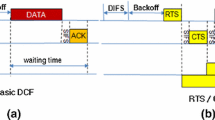Abstract
Currently, communication with resource reservation on ATM networks has been required by popularization of multimedia applications. Types of resource reservation are classified into two types according to reservation timing. One type invokes resource reservation just before communication between users. Another type invokes it in advance. In this type, resources can be reserved with communication time periods invoked by a user, well before actual communication. For the former type, several standardization committees, such as the ATM Forum and ITU‐T, have provided some signaling protocols. However, the latter type has no signaling protocol although necessity of this type has increased. This paper presents approaches of this type at first. Next, it proposes new signaling protocols to support this type keeping consistency with the conventional protocols for the former type, and compares proposed protocols. Moreover, it presents mechanisms to reserve resources cooperating with proposed signaling protocols.
Similar content being viewed by others
References
ATM user-network interface (UNI) specification version 3.1, ATM Forum Specification (1994).
B-ISDN service aspects, ITU-T Recommendation I.211 (1993).
B-ISDN user-network interface layer 3 specification for basic call/bearer control, ITU-T Recommendation Q.2931 (1993).
R. Guerin, H. Ahmadi and M. Naghshineh, Equivalent capacity and its application to bandwidth allocation in high-speed networks, IEEE Journal on Selected Areas in Communications (1991) 968–981.
T. Ikenaga, T. Shinozuka and R. Nakamura, Connection reservation systems for ATM networks, in: IEICE General Conference (1995) B-606.
K. Ishibashi, Traffic modeling based on LAN traffic measurement, in: IEICE General Conference (1997) B-7-208.
P. Koponen, J. Rasanen and O. Martikainen, Calypso services architecture for broadband networks, in: Internat. Conf. on Intelligent Networks and Intelligence in Networks (1997).
M. Nabe, K. Baba, M. Murata and H. Miyahara, Analysis and modeling of WWW traffic for designing internet access networks, IEICE Transactions on Communications B-I, J80 (1997) 428–437.
R. Onvural, Asynchronous Transfer Mode Networks, 2nd ed. (Artech House, 1995).
H. Saito, Toward a future traffic dimensioning method: Non-parametric approach for cell loss rate evaluation, IEICE Transaction on Communications B-I, J76 (1993) 197–208.
T. Yokotani, T. Ichihashi and M. Yabe, An ultra light weight CAC mechanism (UL-CAC) for soft guarantee in ATM networks, in: IEEE 22nd Conf. on Local Computer Network (1997) pp. 432–440.
Rights and permissions
About this article
Cite this article
Yokotani, T., Ichihashi, T. & Tonami, S. New signaling procedures in ATM networks for advance resource reservation. Telecommunication Systems 15, 129–144 (2000). https://doi.org/10.1023/A:1019130525842
Issue Date:
DOI: https://doi.org/10.1023/A:1019130525842




